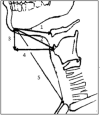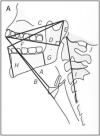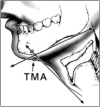Prediction of difficulty in direct laryngoscopy
- PMID: 35750703
- PMCID: PMC9232526
- DOI: 10.1038/s41598-022-13523-4
Prediction of difficulty in direct laryngoscopy
Abstract
To establish easily measurable and reproducible preoperative parameters predicting difficult laryngeal exposure in direct laryngoscopy. A prospective study including 71 patients who underwent transoral microsurgery for benign or malignant lesions of the larynx was performed in our department from January 2021 to November 2021. Physical assessment included the Mallampati score, weight, height, body mass index and measurements of seven parameters in the cervical region. Eleven parameters were measured on the cervical radiography film. Among our patients, 19 were included in the difficult laryngeal exposure (DLE) group. High Mallampati and Cormack scores were significantly associated with DLE (p = 0.005 and p < 0.0001). Limited mouth opening, direct thyromental distance (DTMD) < 67 mm in neutral position, DTMD < 82 mm and sternomental distance < 157 mm at full head extension were statistically related to DLE. For radiological assessment, the effective length of the maxilla and the atlanto-occipital distance were related to DLE. Using stepwise logistic regression, only the effective length of the maxilla and atlanto-occipital distance were selected as independent predictors for DLE (p: 0.015 and 0.001). Preoperative prediction of DLE is useful for both surgeons and patients. The length of the maxilla and the atlanto-occipital distance were found to be independent risk factors for DLE. This highlights the effect of overgrowth of the maxilla, protrusion of the upper teeth and limited extension of the cervical spine as the major risk factors for difficult laryngeal exposure.
© 2022. The Author(s).
Conflict of interest statement
The authors declare no competing interests.
Figures



References
MeSH terms
LinkOut - more resources
Full Text Sources

